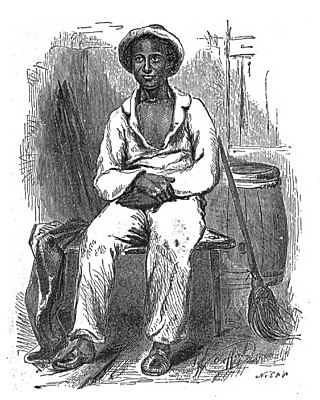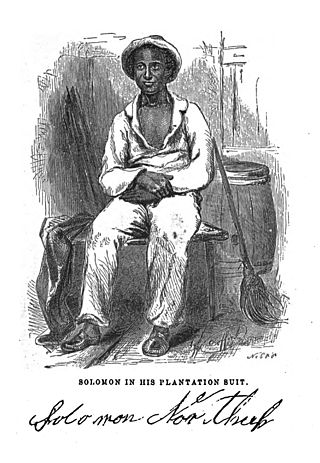
Solomon Northup was an American abolitionist and the primary author of the memoir Twelve Years a Slave. A free-born African American from New York, he was the son of a freed slave and a free woman of color. A farmer and a professional violinist, Northup had been a landowner in Washington County, New York. In 1841, he was offered a traveling musician's job and went to Washington, D.C. ; there he was drugged and kidnapped into slavery. He was shipped to New Orleans, purchased by a planter, and held as a slave for 12 years in the Red River region of Louisiana, mostly in Avoyelles Parish. He remained a slave until he met Samuel Bass, a Canadian working on his plantation who helped get word to New York, where state law provided aid to free New York citizens who had been kidnapped and sold into slavery. His family and friends enlisted the aid of the Governor of New York, Washington Hunt, and Northup regained his freedom on January 3, 1853.

Avery Franklin Brooks is a retired American actor, director, singer, narrator and educator. He is best known for his television roles as Captain Benjamin Sisko on Star Trek: Deep Space Nine, as Hawk on Spenser: For Hire and its spinoff A Man Called Hawk, and as Dr. Bob Sweeney in the Academy Award–nominated film American History X. Brooks has delivered a variety of other performances to a great deal of acclaim. He has been nominated for a Saturn Award and three NAACP Image Awards. Brooks has also been inducted into the College of Fellows of the American Theatre and bestowed with the William Shakespeare Award for Classical Theatre by the Shakespeare Theatre Company.

The Fugitive Slave Act of 1793 was an Act of the United States Congress to give effect to the Fugitive Slave Clause of the U.S. Constitution, which was later superseded by the Thirteenth Amendment, and to also give effect to the Extradition Clause. The Constitution’s Fugitive Slave Clause guaranteed a right for a slaveholder to recover an escaped slave. The subsequent Act, "An Act respecting fugitives from justice, and persons escaping from the service of their masters", created the legal mechanism by which that could be accomplished.

The pre-American Civil War practice of kidnapping into slavery in the United States occurred in both free and slave states, and both fugitive slaves and free negroes were transported to slave markets and sold, often multiple times. There were also rewards for the return of fugitives. Three types of kidnapping methods were employed: physical abduction, inveiglement of free blacks, and apprehension of fugitives. The enslavement, or re-enslavement, of free blacks occurred for 85 years, from 1780 to 1865.

Twelve Years a Slave is an 1853 memoir and slave narrative by Solomon Northup as told to and written by David Wilson. Northup, a black man who was born free in New York state, details himself being tricked to go to Washington, D.C., where he was kidnapped and sold into slavery in the Deep South. He was in bondage for 12 years in Louisiana before he was able to secretly get information to friends and family in New York, who in turn secured his release with the aid of the state. Northup's account provides extensive details on the slave markets in Washington, D.C., and New Orleans, and describes at length cotton and sugar cultivation and slave treatment on major plantations in Louisiana.

Prince Among Slaves is a 2006 historical drama directed, written and produced by Andrea Kalin and narrated by Mos Def made for PBS by Unity Productions Foundation. The film, made in association with Spark Media and Duke Media, is based on the story of Abdul Rahman Ibrahima Sori, a prince from Guinea who was made a slave in the United States and freed 40 years later.

Old Fort House is a historic house at 29 Lower Broadway in Fort Edward, Washington County, New York. The house is owned by the Fort Edward Historical Association and operated as a local history museum. The Old Fort House was listed on the National Register of Historic Places in 1983.

12 Years a Slave is a 2013 biographical drama film directed by Steve McQueen from a screenplay by John Ridley, based on the 1853 slave memoir Twelve Years a Slave by Solomon Northup, an African American man who was kidnapped in Washington, D.C. by two conmen in 1841 and sold into slavery. He was put to work on plantations in the state of Louisiana for 12 years before being released. The first scholarly edition of David Wilson's version of Northup's story was co-edited in 1968 by Sue Eakin and Joseph Logsdon.

William Prince Ford was an American Baptist minister, preacher and planter in pre-Civil War Louisiana. He was the slave owner who first bought Solomon Northup, a free African-American, after Northup had been kidnapped in Washington, D.C., and sold in New Orleans in 1841. He resided in the "Great Pine Woods", Avoyelles, Red River Parish, Louisiana, and he ran a farm there. At the same year, Ezra Bennett, a Bayou Boeuf storekeeper and planter, lived near the plantation of Prince Ford and gave him instructions to his factors.
Twelve Years a Slave is an 1853 memoir by Solomon Northup.

Patsey was an African-American enslaved woman. Solomon Northup wrote about her in his book Twelve Years a Slave, which is the source for most of the information known about her. There have been two adaptations of the book in film, Solomon Northup's Odyssey in 1984 and the better known 12 Years a Slave, in 2013. In the latter Patsey was portrayed by Lupita Nyong'o, who won the Academy Award for Best Supporting Actress for her performance.
A House Divided: Denmark Vesey's Rebellion is a 1982 television film about Denmark Vesey, a literate skilled carpenter and former slave who planned a slave rebellion in 1822 in Charleston, South Carolina. Denmark Vesey's Rebellion was produced by WPBT and PBS, and Yaphet Kotto played Vesey.
Edwin Epps was a slaveholder on a cotton plantation in Avoyelles Parish, Louisiana. He was the third and longest enslaver of Solomon Northup, who was kidnapped in Washington, D.C. in 1841 and forced into slavery. On January 3, 1853, Northup left Epps's property and returned to his family in New York.

John Neares Carter was an American film editor. He rose to the ranks at CBS on the Ed Sullivan Show, becoming the first African-American film editor to be employed by network television in New York. For the last four of his twelve years with CBS, he was the supervising film editor for the award-winning documentary unit, Eye On New York. John left CBS to form his own company John Carter Associates, Inc.
James H. Birch was an American slave trader in the District of Columbia.
Samuel Bass (1807–1853) was a white Canadian abolitionist who helped Solomon Northup, author of Twelve Years a Slave, attain his freedom. Northup was a free black man from New York who was kidnapped and forced into slavery in the Deep South. At risk of injury and conviction in default of the Fugitive Slave Act of 1850, Bass mailed letters to friends of Northup that initiated a series of events to save him.
Sue Eakin (1918–2009) was an American history professor at Louisiana State University of Alexandria. She received a National Endowment for the Humanities Fellowship and was made a Fellow of American Association of University Women. Eakin researched the story of Solomon Northup, Twelve Years a Slave, and published a version of the book that corrected historical inaccuracies.
David Fiske is an author, local historian, and a retired librarian residing in Ballston Spa, New York. He has written several books related to Solomon Northup.

Theophilus Freeman was a 19th-century American slave trader of Virginia, Louisiana and Mississippi. He was known in his own time as wealthy and problematic. Freeman's business practices were described in two antebellum American slave narratives—that of John Brown and that of Solomon Northup—and he appears as a character in both filmed dramatizations of Northrup's Twelve Years a Slave.












